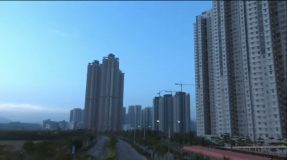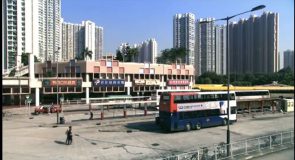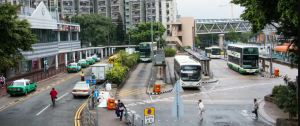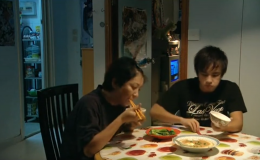THE WAY WE ARE, DIR. ANN HUI (2008)
Tin Yiu Estate, Yuen Long District, Hong Kong
The Way We Are (天水圍的日與夜), directed by Ann Hui, is released in 2008. The story takes places in Tin Yiu Estate, Tin Shui Wai.
By presenting the film as a documentary, Ann depicts the everyday lives of 貴姐’s family and their newly moved-in neighbour, 阿婆梁歡, who both lives in Tin Shui Wai in a down-to-earth and realistic way. The film does not have a climax or ending, but it shows typical family struggle and harshness of people’s life at that time. To a greater aspect, it also reflects several social problems, such as NEETs and family estrangement. This is very successful in resonating with audience their ordinary life. Although there is not any climax or exciting part, it is relaxing for audience to have enjoyed the whole film with smiles on their face. It is probably due to two key factors: the mediocre but outstanding storyline and photographing techniques.
The film starts in a beautiful morning scene of Tin Shui Wai, captured in a 360-degree way. High-rise densed building signifies the position of Tin Shui Wai as a modern developed new town.
 Morning Tin Shui Wai as a starting scene, beautiful and peaceful.
Morning Tin Shui Wai as a starting scene, beautiful and peaceful.
Generally, Tin Yiu Estate presented in the film is nearly the same as experienced in reality. As a new town, dense buildings are located on the land, traffic facilities, crossed roads are well-equipped to it. People are all busy working anywhere: supermarket worker, cashier etc. According to Hui in an interview, the protagonists and pedestrian shown in the film are designed based on the citizens living there. Moreover, the background of the two flats being used as filming, including the furnitures, belongs to real residents of Tin Yiu Estate. Hui preserves all the details, and has spent great endeavour in showing the true face of this new town.

Left: Tin Yiu Bus Terminus, Tin Yiu Estate.Scene from The Way We Are 2008, directed by Ann Hui.
Right: Tin Yiu Bus Terminus, Tin Yiu Estate. Figures found on google.(Realistic)
Zooming into the flats, Hui uses significant proportion of time to showcase the daily activities of local citizens, as reflected by protagonist in the film: Walking around supermarket, watching newspaper and TV, cooking and dining at home etc. All of these can actually happen at the time I am writing this text. Along with comfortable music, the ‘reel’ time seems to has become the real time, bringing audience into an ordinary Tin Shui Wai ciziten’s life before they can notice.

Scene from The Way We Are 2008, directed by Ann Hui.
Before investigating why Tin Shui Wai is presented in this way, there is one very important thing we have to know. At the time 2008, Tin Shui Wai as portraited by newspaper editors as ” a place with sadness that breeds murders”. Most citizens there are new immigrant from mainland or South Asian. Such a public stereotype towards this place could perhaps interested Hui, and that becomes the reason Hui chose Tin Shui Wai as the venue. Hui wants to reveal and discover more about this mysterious place.
In the film, however, there is never a linkage between Tin Yiu Estate and its evil nickname on newspaper. It is just a mediocre public housing estate in Hong Kong. No special features, no special campaigns. As the setting of the story, despite the fact that Hui uses the life of 貴姐, a grassroot family as a microscope to the city, the entire estate is also filmed several times in a wide angle—beautiful and peaceful. We can see that Hui, through this film, is dedicated to fade away the bad public image towards the place, and bring them a new one. Beneath the murder scene we actually see on newapapers, there are countless of other scenes. Love, friendship, neighbourhood, as seen in the movie, all breed in this small town. Citizens do all have their own story–as if everyone of them is a 貴姐. A new one of themselves is the new one of them towards Tin Shui Wai.
Upon watching the film, the audience are not expected to react excitedly, but to ponder and reminisce about their own pasttime, as brought by 貴姐 and阿婆歡。I believe it may not be full of happiness, but the fact that it is mixed with endeavour and sweat makes it more precious. To me, as a local citizen living in Tin Shui Wai, it brings me back to my childhood time. Meeting the security in the estate lobby and got a candy from her hand, then going to the small ‘Rainbow Tuckshop’ and bought snacks.
What will you have in your mind after watching the film? Comment and share with me what you have found interesting abou the film! Watch the full video clips on Internet if you want to experience and discover more about the ordinary life of Tin Shui Wai (or any other public housing estates’) citizens!
— Tsang Ka Ho, 3035924310
I appreciate how you understood Tin Yiu Estate in the Way We Are as well as your thorough observation. I would suggest you go in-depth based on ideas/concepts/theories of coursework, such as de Certeau’s argument of city and everyday practice. Furthermore, filmmakers tell a visual story by marrying sight, sound, and music to communicate with the audience. So how Dir Hui processed his lens technically to evoke audiences’ empathy is also worth a reflection. Please clearly figure out your references to clarify how you accessed the field research.